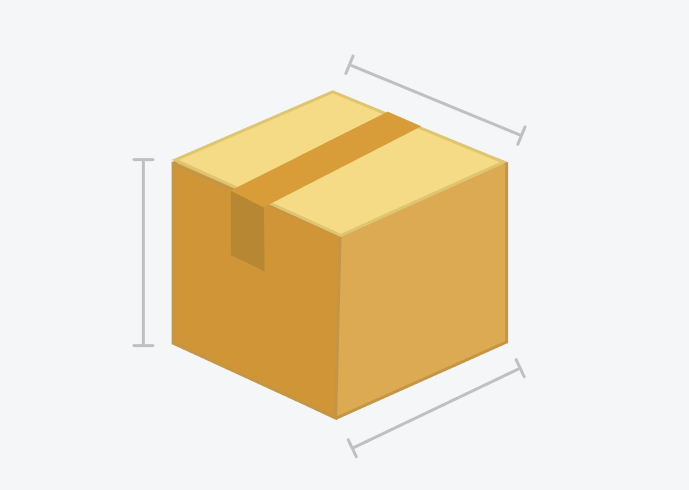How the girth measurement affects the shipping costs
The shipping costs for a package or pallet are based on the weight and size. If an incorrect entry is made when booking the shipment, the difference is usually charged by the shipping service providers and freight forwarders. In addition to the volumetric weight, the girth measurement is the key figure that you should understand in order to be able to calculate the shipping costs correctly in advance.

How to calculate the girth measurement?
You can easily calculate the girth of your shipment yourself by measuring all the edges, doubling the sum of the height and width and adding it to the length:
Girth = (height + width) x 2 + length
All dimensions must be given in centimetres.
Example:
A parcel measures 30 cm x 40 cm x 50 cm
Girth = (30 cm + 40 cm) x 2 + 50 cm = 260 cm
Girth Calculator
National
The girth is an important measurement for shipping packages within the national area. It is used to determine the size and shipping costs for packages.
International
For international shipping, the girth may need to meet additional requirements. It ensures that packages comply with international shipping regulations.
What is a girth measurement and how does it affect shipping costs?
The girth measurement is an important factor in calculating shipping costs. Many shipping companies use it together with the weight to determine shipping costs. The larger the measurement of a package, the higher the shipping costs usually are.
The reason is simple: the larger and more voluminous a package is, the more space it takes up during transport. This results in higher transport costs per unit, which in turn is reflected in higher shipping costs. In order to make optimal use of the available transport space and to avoid packages that can no longer be handled with reasonable effort, the girth dimension limits the maximum size of shipping units. Parcels and pallets that exceed the specified dimensions must be sent as bulky goods or by freight forwarder.
When is the girth measurement used?
In principle, both for national and international shipping. However, DHL has defined the maximum permissible package dimensions for national shipping in such a way that it is no longer possible to exceed the girth measurement with DHL.
For international shipping, however, the maximum permissible package size is misleading as the only specification. For example, DHL allows the same package size as for national shipping, 120 x 60 x 60 cm = 360 cm. However, for international shipping, only 300 cm is permissible. While the package would still be within the permissible range for domestic shipping, it would be too large for international shipping. There are also differences between the various shipping companies. While the maximum length for UPS, DPD and DHL is 300 cm, it is 330 cm for FedEx.
Always take the volume weight into account.
LetMeShip – your unrivalled personal multi-carrier shipping platform
For over 20 years, we have been helping small and medium-sized companies to handle their business shipping in a cost-effective and efficient way. ‘LetMeShip’ stands for: personal advice; an in-house customer service that also answers the phone and takes care of all your needs; the best price-service performance – and all without a contract.
The strap length is not the same as the package length
Some shipping companies specify maximum permissible dimensions for packages and pallets, e.g. DHL 120 x 60 x 60 cm or FedEx a maximum length of 274 cm. There are a few things to bear in mind here:
- The girth measurement is dependent on the package dimensions. However, it is not necessarily the case that it will be adhered to if the package has a permissible dimension.
- It is possible that a prepared package will just meet the girth measurement and still be charged extra.
The first case is quickly explained: if a service provider only specifies a maximum permissible dimension for one side, the belt dimension – which is dependent on all three edge sides – can easily be exceeded, even though the side dimension has been adhered to. Let’s take FedEx and a parcel with a permissible length and 15 cm in height and width:
274 + 2 x (15+15) = 338 cm
FedEx allows a maximum permissible size of 330 cm, so the parcel would be too large.
The size of the shipping box is not the same as the girth
The second case is a little more complicated. Assuming the package was picked up and measured by laser at the distribution centre. Suddenly it is larger than stated. What happened? There are three main reasons:
- The box is too small and the contents are pushing outwards. This changes the side dimensions and your shipment may be larger than the original box size.
- The box is not sturdy enough and is compressed during transport, for example by other packages stacked on top of it. Again, the side dimensions change.
- The box dimensions may indicate the internal dimensions and not the external dimensions.
So you can see that it is important to
- calculate the strap dimensions yourself and
- allow for a 1–2 cm buffer
Otherwise, you may be charged extra if the permissible dimensions are only just met and your parcel becomes deformed during transport.
Tips for cost reduction
To reduce your shipping costs, you can try to reduce the girth. Here are some tips:
- Pack your goods as compactly as possible.
- Use sturdy cardboard boxes to avoid bulges
- Check whether it makes more sense to send several smaller packages instead of one large one
Our customer service will be happy to help you with any questions about correct and safe packaging.

Just ask us personally
Shipping requirements in companies are often complex and time-consuming. A task for which you can count on our support. Contact us today and find out more about our shipping services for B2B customers!
Historical origin
Package sizes must be limited so that they can be handled at all. This is all the more true in times of fully automated distribution systems, which no longer allow all sizes to pass through.
The question now arises as to how? Simply specifying a maximum length is not enough. Take FedEx, for example: since the maximum length is only 274 cm, a block of 274 x 274 x 274 cm would theoretically be possible, but so would a straightforward parcel of 274 x 10 x 10 cm. The strap length solves this problem, since if one side is very long, the other two must automatically be shorter.
The term probably comes from a common practice before the introduction of laser parcel measurement, although this is not historically certain. When parcels were accepted, employees were given a standardised belt that they had to wrap once completely around the shorter sides of the parcel. If the longest side of the parcel was shorter than the remaining belt, it was deemed to be within the dimensions.

